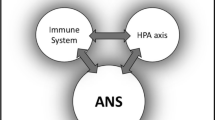Abstract
Experiments conducted on 10 adult male Chinchilla rabbits showed that single 5-sec electrostimulation of the region of the medial hypothalamus induces a series of stereotyped behavioral responses in the form of synergic thumping on the floor of the experimental chamber. When the stimuli are repeated. every 1.5–2 min adaptation to stimulation is observed, which is expressed in in a gradual decrease of the number of thumps. To study the pharmacological and hormonal effects on the described behavior, an experimental model is proposed which consists of two series of stimulation, each of which consists of 10 successive stimuli. The investigated pharmacological agent (cortisol [hydrocortisone] hemisuccinate) was injected into the animals in the interval between the two series of stimulation. A statistical analysis of the experimental results showed that intraperitoneal injection of cortisol in doses of 10 and 20 mg/kg enhances the simulation-induced behavioral response and shortens the latent period of its manifestation compared with the control. Key words: rabbit, electrostimulation, medial hypothalamus, stereotyped behavior, cortisol.
Similar content being viewed by others
Literature cited
V. P. Belyi, “Inhibiting effect of hydrocortisone and corticotropin on the self-stimulation response,” Zh. Vyssh. Nervn. Deyat.,29, No. 5, 948 (1979).
V. P. Belyi, “Microiontophoretic study of the topography of hydrocortisone-sensitive neurons of the rabbit brain,” Probl. Éndokrinol.,26, No. 1, 58 (1980).
B. Gonzalez, A. Sabinier, and V. P. Belyi, “Thumping behavior of rabbits in relation to the strength of electrostimulation of hypothalamic structures of the brain,” Zh. Vyssh. Nervn. Deyat.,34, No. 1, 62 (1984).
K. Lishak, G. Kovach, and G. Telegdi, “Participation of the serotoninergic system in mediation of the effect of corticosteroids on protective behavioral responses,” in: News about Hormones and Mechanism of Their Action [in Russian], Naukova Dumka, Kiev (1977), p. 180.
N. M. Malyshenko, “Role of corticosteroids in the formation of fear and aggressive reactions,” Zh. Vyssh. Nervn. Deyat.,32, No. 1, 144 (1982).
I. Ya. Podol'skii, “Selective dopaminergic stimulation of stereotyped forms of aggressive and defense behavior,” Byull. Éksp. Biol. Med.,83, No. 4, 432 (1977).
L. A. Sever'yanova, “Role of ACTH and corticosteroids in aggressive and defense behavior of rats,” Fiziol. Zh. SSSR,67, No. 8, 1117 (1981).
E. Fifkova and J. Marshall, “Stereotaxic atlases of the cat, rabbit, and rat brain,” in: Electrophysiological Methods of Investigation, J. Buresch, M. Patran, I. Zachar [Russian translation], Izd. IL, Moscow (1962), p. 386.
S. L. Black and C. Vanderwolf, “Thumping behavior in the rabbit,” Physiol. Behav.,4, No. 4, 445 (1969).
B. Bohus, “Behavioral effect of pituitary-adrenal system hormones,” in: The Endocrine Function of the Human Adrenal Cortex, V. N. T. James et al. (eds.), Proc. of the Serono Symposia, Acad. Press, London, Vol. 18 (1978), p. 105.
J. F. Flood, D. Vidal, E. L. Bennet, F. E. Orme, S. Vasquez, and M. E. Jarvic, “Memory facilitating and anti-amnesic effects of corticosteroids,” Pharmacol. Biochem. Behav.,8, No. 1, 81 (1978).
I. Mandelbrod, S. Fallman, and R. Werman, “The effect of iontophoretic application of putative neurotransmitters on the electrical activity of rat mediobasal hypothalamic neurons in relation to their steroid sensitivity,” Brain Res.,272, No. 1, 115 (1983).
P. B. Sawin and R. H. Curran, “Genetic and physiological background of reproduction of the rabbit,” J. Exp. Zool.,120, No. 2, 165 (1952).
W. E. Stumpf and M. Sar, “Steroid hormone target sites in the brain: The differential distribution of estrogen, progestin, androgen, and glucocorticosteroid,” J. Steroid Biochem.,7, No. 9, 1169 (1976).
Author information
Authors and Affiliations
Additional information
Translated from Fiziologicheskie Zhurnal SSSR imeni I. M. Sechenova, Vol. 72, No. 8, pp. 1048–1054, August, 1986.
Rights and permissions
About this article
Cite this article
Belyi, V.P., Gonzalez, B.B. Effect of cortisol on a model of stereotyped behavior of rabbits in the form of thumping. Neurosci Behav Physiol 17, 340–345 (1987). https://doi.org/10.1007/BF01183065
Received:
Issue Date:
DOI: https://doi.org/10.1007/BF01183065




